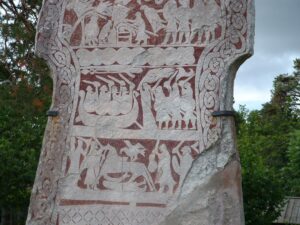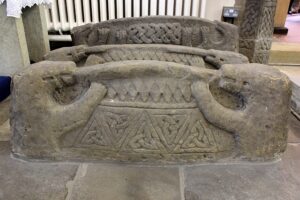Animals such as wolves, horses, bears, dragons, and serpents were depicted as evil symbolisms and related to death during the Viking Age.
 Stone from Tjängvide, SE. |
Death is often linked to warriors in battle, especially with the large amount of imagery focused on Odin’s hall of slain warriors, Valhöll. This image of a Viking Age picture stone depicts a horse leading a slain warrior, or Odin himself, to Valhalla. Images like this one often present a horse with the warrior as they were commonly used in Viking raids and battles. |
| “She saw men wading through heavy streams; some were oath-breakers, others had murdered, some had lured women to love. There the Serpent sucks on corpses, the Wolf rends dead men. Seek you wisdom still?” Völuspá, 28 |
The Völuspá describes scenes of death and the halls of Hel with various animal mentions, such as poison snakes and man-eating wolves. |
| “He ties the heads of the cows or the sheep to the piece of wood set up in the ground. When night falls, the dogs come and eat it all up, and the man who has gone to all this trouble says, ‘My lord is pleased with me and has eaten my offering.’”
Ibn Fadlan, 77 |
Ahmad ibn Fadlan also wrote about the use of dogs to consume sacrificed animals and unburied slaves with the Norse believing that their gods were the ones removing the bodies. This acts as a commentary of ibn Fadlān against Northern religious beliefs and funerary practices by likening the Norse to dogs. |
 Stora Hammars I, SE. |
This Viking Age Gotlandic picture stone is from Stora Hammars, Lärbro and shows five narrative scenes, each contained in a separate register. There is a battlefield scene, with pairs of warriors on either side of a corpse beneath a riderless horse, towards which a predatory bird swoops. Both horses and birds are symbolic of warrior deaths and moving on to the Norse afterlife. |
| “And you’re the stepson of King Siggeir, and you dwelled in the forest with wolves and later all kinds of bad fortune came to you. You killed your own brothers, and made yourself a bad reputation.”
Saga of the Volsungs, 16
|
The Saga of the Volsungs is an Icelandic text from the 13th century about the origin and generations of the Volsung clan. This saga discusses the dark magic of a deadly sacrificial cow that fights in battles. It also references shapeshifting of humans into wolves and taking on the worst of qualities. |
 Brompton Hogback Stones, UK. |
These are stone monuments shaped like Viking Age longhouses found in Brompton church, North Yorkshire, with gable-ends mysteriously clasped by bears. Bears in the Viking Age represent superhuman strength, another animal represented with human shapeshifting during the Viking Age. |
Crawford, Jackson, trans., The Saga of the Volsungs (Indianapolis: Hackett Publishing, 2017).Graham-Campbell, James. Viking Art. 3rd ed. London: Thames and Hudson, 2021.
Ibn Faḍlān, Aḥmad. “Mission to the Volga,” edited by James E. Montgomery. In Two Arabic Travel Books: Accounts of India and China, edited by Philip F. Kennedy and Shawkat M. Toorawa, 163–297. Library of Arabic Literature. New York: New York University Press, 2014.
Terry, Patricia, trans. “Völuspá.” In Poems of the Elder Edda, 2nd ed., 1–10. Philadelphia: University of Pennsylvania Press, 1990.
« Previous | Home | Next »